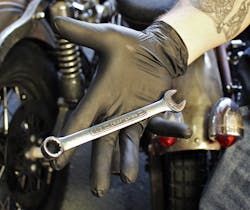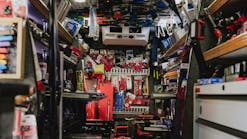When it comes to apparel, technicians need to know what they are purchasing will enhance their safety and keep them comfortable while they are in the shop and on the job. Mobile tool distributors who are able to provide their customers with product offerings that meet those demands -- at the right price, of course -- can readily expect to see an increase in sales in this category.
“Technicians are looking for high quality products at a competitive price,” says Alex Barnes, marketing manager, Adenna, a provider of hand protection products for a variety of industries (www.adenna.com). “When a technician decides to buy it is usually because the product is good quality and readily available at an affordable price.”
Safety first
High-quality shop apparel is designed to hold up in a work environment where technicians regularly come in contact with tools, equipment, chemicals and other items that could cause them harm. In addition to embracing best practices and following appropriate safety protocols, technicians need to concern themselves with what they are wearing while conducting vehicle maintenance and repairs. According to Barnes, a desire to ensure personal safety is often the number-one reason technicians decide to invest in new apparel. Gloves, for example, help prevent technicians from sustaining common work-related injuries such as cuts, scrapes and burns. They also help with long-term safety, she says.
“Many technicians are much more educated when it comes to using different solvents and chemicals, and they know now that these can have an effect on their health down the road if they do not use the correct protective apparel,” states Barnes.
Understanding the importance of safety in the workplace is critical, says Cory Houston, marketing, Mechanix Wear, a provider of work gloves for a variety of applications (www.mechanix.com). He says that, according to the data compiled by the National Safety Council, the average cost of a hand injury is $20,000 or $21,000 in medical costs and missed time from work.
“That’s a hefty cost and, when it comes down to it, a pair of gloves is a pretty low-cost safety measure,” he adds.
Comfort and durability matter
Proper footwear also provides significant benefits for technicians. According to Charlie Arroyo, general manager, Redback Boots USA, a provider of work boots and safety footwear (www.redbackboots.com), the average technician spends anywhere from 10 to 14 hours a day on his or her feet. In some cases, footwear is adversely affecting comfort and productivity. Those technicians who wear boots on a regular basis, says Arroyo, should seek out wider fitting offerings that provide significant comfort, ASTM/OSHA certified safety features that allow for work to be done safely and efficiently, as well as a durable design to ensure they are up to the task day after day.
“Technicians’ feet take a beating, so (they have to) make sure they are in quality footwear to keep them comfortable and safe at work,” he says.
“Good footwear does not make you tired,” Arroyo continues. “A tired tech can make mistakes and that can cause to workplace injuries. A good choice of footwear will provide comfort, safety and durability.”
Looking professional
Cleanliness is an often-overlooked apparel purchasing consideration, but it is a significant one for any technician looking to come across proper and professional in certain situations. When a job requires talking with a customer or filling out paperwork in an office setting, the dirt, grease, grime and chemical residue from the shop come along with him or her.
“Many customers will notice if the front of a shop is just as dirty as the back, or paperwork has grime and smears all over it,” says Barnes. “And they may take that into account when deciding which technician is right for the job.”
Selling strategies
One of the most effective ways a mobile tool distributor can motivate technicians to invest in apparel is by having various products and sizes readily available on the tool truck for them to see, feel and try on at a moment’s notice. When it comes to gloves, says Barnes, customers looking to make a purchase often have questions that require answers, and they also want to know how one brand’s offering compares to others in terms of price, material and thickness.
It is critical for mobile tool distributors to determine what sort of apparel purchases their customers have made in the past and their level of satisfaction with those particular offerings. It is also important to make sure those offerings do not sacrifice anything in the way of comfort, safety or durability. Furthermore, distributors must make an effort to ensure customers are pleased with the prices they are paying for their current apparel.
“If the technician brings up that their gloves rip easily, deteriorate in the solvents or chemicals that they use, or their hands don’t fit well in their current gloves, these are all cues and openings for a mobile tool distributor to show a comparable glove from Adenna to the technician and start selling,” she adds.
Houston says it is very important to find out what type of work the customer is doing, as Mechanix Wear offers products that have a variety of different features meant for specific applications.
“What’s happening is that gloves are getting more specialized,” he continues. “And from a tool distributor’s perspective, I think they need to be more educated on gloves to help a customer find the right pair.”
In stock
Many apparel brands have different styles of apparel available for purchase, so distributors need to be aware of that fact when stocking their truck. In addition, they should keep a few options or sizes of each type of apparel so they do not run out of samples for technicians to try on when considering a variety of options.
“We have found that samples of our product and being able to test and try on our gloves makes the sale that much easier,” says Barnes. “If a technician can try on the glove that a mobile tool distributor is trying to sell, then they can feel the difference first-hand and even take that sample back into their shop and try it out.”
Arroyo points out that having a choice of footwear offerings on the truck helps stir up technician interest and shows that a distributor is able to meet their individual needs and wants.
“Consumers are all about instant gratification,” he says. “Having the popular sizes in stock is so important to capture any interested technician.”
Lastly, how the apparel is packaged should not be overlooked by distributors when trying to incite technician interest in making purchase, as it is a critical element to securing a sale.
“If a mobile tool truck can display the glove boxes so that they are in the line of sight of the technician, then the product packaging will catch the eye of the technician and start conversation about our product with much more ease than having to bring up the topic by asking sales questions,” says Barnes.


